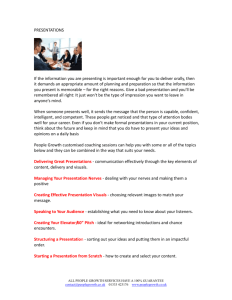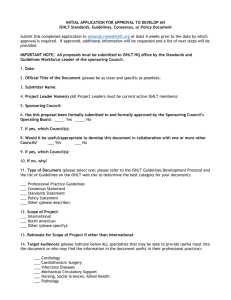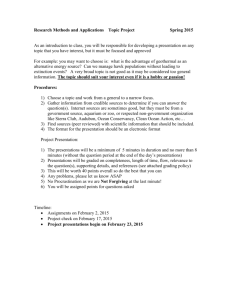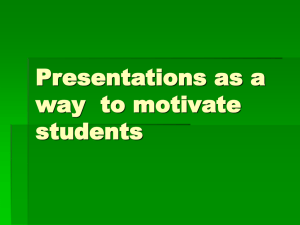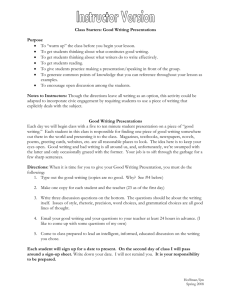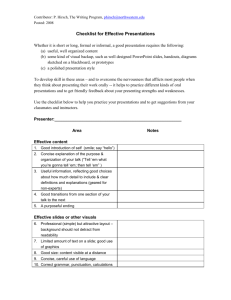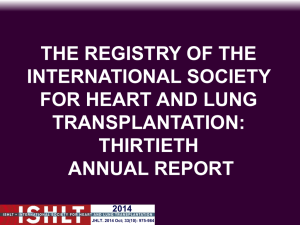Procrastination, Preparation, Presentation, Prague
advertisement
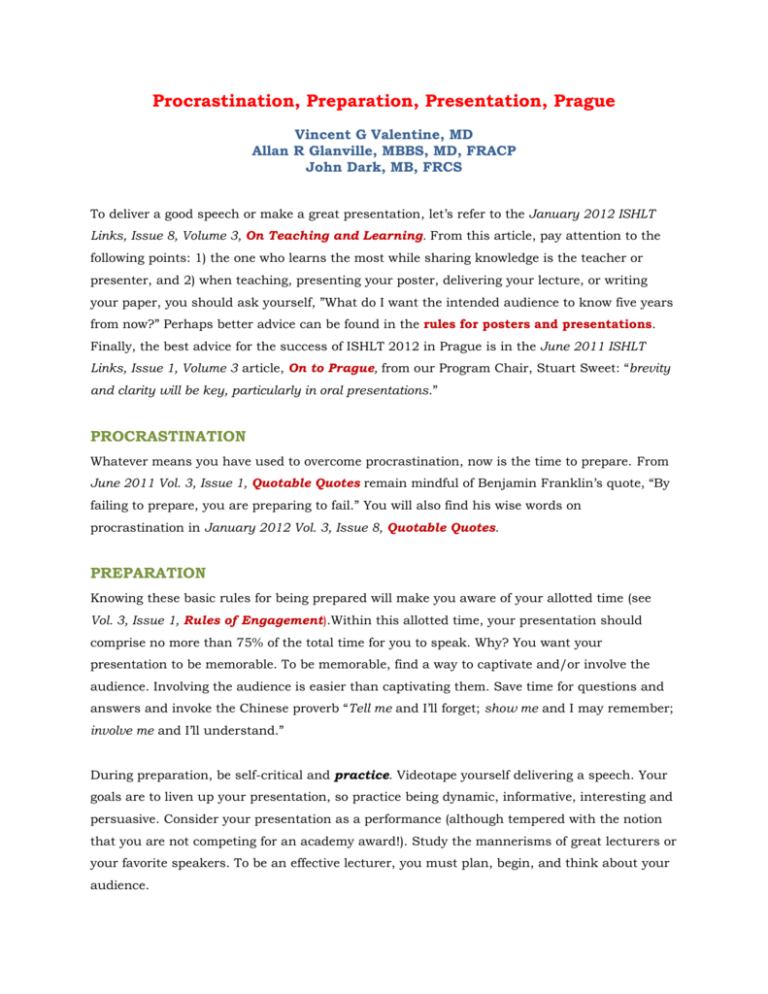
Procrastination, Preparation, Presentation, Prague Vincent G Valentine, MD Allan R Glanville, MBBS, MD, FRACP John Dark, MB, FRCS To deliver a good speech or make a great presentation, let’s refer to the January 2012 ISHLT Links, Issue 8, Volume 3, On Teaching and Learning. From this article, pay attention to the following points: 1) the one who learns the most while sharing knowledge is the teacher or presenter, and 2) when teaching, presenting your poster, delivering your lecture, or writing your paper, you should ask yourself, ”What do I want the intended audience to know five years from now?” Perhaps better advice can be found in the rules for posters and presentations. Finally, the best advice for the success of ISHLT 2012 in Prague is in the June 2011 ISHLT Links, Issue 1, Volume 3 article, On to Prague, from our Program Chair, Stuart Sweet: “brevity and clarity will be key, particularly in oral presentations.” PROCRASTINATION Whatever means you have used to overcome procrastination, now is the time to prepare. From June 2011 Vol. 3, Issue 1, Quotable Quotes remain mindful of Benjamin Franklin’s quote, “By failing to prepare, you are preparing to fail.” You will also find his wise words on procrastination in January 2012 Vol. 3, Issue 8, Quotable Quotes. PREPARATION Knowing these basic rules for being prepared will make you aware of your allotted time (see Vol. 3, Issue 1, Rules of Engagement).Within this allotted time, your presentation should comprise no more than 75% of the total time for you to speak. Why? You want your presentation to be memorable. To be memorable, find a way to captivate and/or involve the audience. Involving the audience is easier than captivating them. Save time for questions and answers and invoke the Chinese proverb “Tell me and I’ll forget; show me and I may remember; involve me and I’ll understand.” During preparation, be self-critical and practice. Videotape yourself delivering a speech. Your goals are to liven up your presentation, so practice being dynamic, informative, interesting and persuasive. Consider your presentation as a performance (although tempered with the notion that you are not competing for an academy award!). Study the mannerisms of great lecturers or your favorite speakers. To be an effective lecturer, you must plan, begin, and think about your audience. What about “ticks and fleas”? Are they distractions to your performance? Identify and suppress your verbal and nonverbal tics. Some common verbal tics are: “hmmm,” “ahh” and, “you know.” Recently a speaker said, “hmmm – K” after every sentence. And let’s not forget “sort of,” “like,” “whatever,” “really,” and “seriously.” You’ve got to be kidding! These verbal tics impair your ability to project purpose and confidence. They also waste time, and time is of the essence in a scientific presentation. You will notice that some speakers just can’t stand still. Remember to stand upright. Don’t lean on the lectern (unless very drunk from the night before) or stand still for a long time. Walk around, and consider standing in front of the lectern instead of behind it. (Do not dance, however.) Use hand gestures economically. Be careful about swaying, using bizarre or repetitive gestures. Videotape and study these tapes of your presentations—be self-critical before others have the chance to criticize. Dramatic silences are powerful, especially when accompanied by the right facial expression. Will the results confirm or refute the hypothesis? Will the patient live? And remember, appearance is important. The old adage applies here, especially for us silvertongued, graying bunch: “We may not be any good, but at least we try to look good.” In other words, dress to impress! During your presentation, smile, make eye contact and choose your mood. You know your topic, so show passion for your topic. Bring enthusiastic energy and delight to your subject! Study the recent success of Harvey Weinstein (a movie mogul and winner at the podium). He turned two movies into Best Picture Academy Award winners for two consecutive years. The King’s Speech (2011), is a movie about an English king who, to cope with a stammer, seeks help from an Australian speech therapist. (In keeping with our best performers of the ISHLT— who is the Australian and who is the Englishman here?) The other, The Artist (2012), is a silent movie; these two films are proof that overcoming "a tic" and well-time pauses of silence are very successful and quite theatrical. PRESENTATION With these points in mind, you are now on the road to a great formal presentation. Through repetition and review you will know your topic better than most—if not the entire—audience, therefore you must keep your presentation simple, especially simple from your point of view. But this audience still knows the background. The ISHLT does not need to be told that “lung transplantation is an accepted treatment for end-stage pulmonary disease” or something equivalent, an often predictable opening line. Don’t insult the listener by stating something they know! Begin your presentation by introducing your topic. – Introduction Approach and means to support or refute your topic. – Methods Talk about your topic by giving details and various means of supporting your topic. – Results and Discussion Finally, summarize your topic. – Conclusions Let’s restate the above with a few more details. Tell the audience what you will say, then say it and repeat what you have just told them. Keep your messages clear and simple. Lively and animated speakers with an upbeat cadence and movement are more entertaining and memorable, engage the audience, add humor where appropriate—at some point, the audience must smile!—but don’t overdo it. Include full disclosures at the beginning and references at the end. Leave time for questions. A Few Words on Slides Today, PowerPoint presentations (slides) have become necessary for delivering information during our ISHLT meetings. As with anything in life, there are benefits and hazards of using slides. They are just one of many different teaching technologies. We must use them wisely and effectively. Living by slides could lead to dying by slides. Above all, prepare any presentation as if there are no slides—there may be some unforeseen technical difficulty. There is no substitute for an actual person speaking persuasively with a commanding and gripping performance that holds the attention of the audience. Slides are used most effectively for an outline, complicated diagrams, and pictures. While preparing, you might ask, what will my audience gain by using slides? What will my presentation lose? Be aware how the audience divides their time between you and the screen. Slides can interfere with the audience-lecturer relationship. What happens when the lights are dimmed? It provokes sleep! With this thought, remember—NEVER read from your slides!!! They are there to enhance and clarify, not duplicate, not become a substitute or, certainly, not distract. The slides must supplement your talk, not act as a prompt. What you say must differ from what the audience reads—repetition is a further waste of time … a squandering of opportunity. Keep your slides as simple as possible— simple and direct. Each slide should convey one idea, have one diagram, or contain one or two pictures. You will never have to apologize for a cumbersome table if you never show one! And again, do not insult the audience by prefacing a slide with, “as you can see here.” When you proceed on to a descriptive topic while being persuasive, don’t leave the slide on the screen. Avoid gimmicks, avoid noises, avoid added colors, avoid fancy colors, and avoid stripes. These are all distractions. There are enough studies indicating the most effective slide design for audience friendliness is either black words on a white background or off-white (eggshell) or yellow words on a dark blue background. Avoid red and green words and backgrounds. Use pictures. For content, use case-based presentations or wellplaced jokes to enhance and possibly clarify your presentation into a more memorable one. Keep slides simple. Finally, plan not to use a pointer. The audience is distracted when you turn away, and the microphone may lose your voice. If there is multi-screen projection, the pointer is seen on only one. Using the mouse is an alternative, but you have to look at the screen, thereby losing eye contact. Instead, build pointers into your slides—arrows on a photo, underlining a key part of a table, encircling the data you are referring to, etc. Before the session starts, always check the podium and, ideally, talk to the projectionist, if there is one. Will they display your opening disclosure slide? What mechanism advances the slides (mouse, button, keyboard)? Who controls the lights? Is there a timer controlled by the Chair? Doing all this ahead of time makes you look professional and avoids embarrassing pauses and gaps. While speaking, vary your sentence length. Use short action verbs and short crisp sentences. Long complex words are even more difficult to pronounce correctly in front of 2000 people. Use rhetorical questions (frequently more informative) rather than making declarative statements. Be aware of your tone of voice, variations in volume, and appropriate gestures. Vary your vocal inflections from loud to soft and from a high pitch to a low pitch. Paradoxically, the audience pays closer attention when you become quieter. Do not speak in monotone. Convey the idea to the audience that there is no place you’d rather be than talking about the topic you are enthusiastically delivering free from any distraction. Passion—and commitment to the subject—matter most when giving a presentation. DO NOT READ YOUR LECTURE OR PRESENTATION. Written and spoken presentations differ. Presentations and speeches are spoken, so be a conversationalist. Pay attention to gestures and use of eye contact. You want to connect with and monitor the reaction of the audience as they listen to you. Otherwise, how do you know if you’re getting your message across? Study body language and try not to look at your notes. Do not memorize your entire lecture, but memorize the sequence of important things. Most of all, DO NOT EXCEED YOUR TIME LIMIT by cramming too much material in your presentation. Know your time limit—this applies just as much during hours as after. PRAGUE The most important goals of your presentation are to make the audience feel they have learned something and have enjoyed themselves. Nevertheless, when all is said and done, it may not make a difference. Sometimes, “you can’t teach that!” So instead, follow the Irish custom Pota Phadraig (or Patrick's Pot): "drown the shamrock" and have a beer! Disclosure Statement: The authors have no conflicts of interest to disclose.
